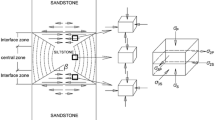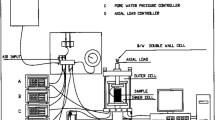Summary
Consolidated-undrained triaxial compression tests were performed on specimens trimmed from eight different labotatory prepared samples of a kaolin clay. The samples covered a wide range of micro-fabrics, and specimens were trimmed parallel and perpendicular to the direction of preferred particle orientation. The micro-fabric of each sample was identified by the combined use of scanning electron microscopy, optical microscopy, and X-ray diffractometry, the latter of which gave a quantitative index that was correlated with the directional dependence of the ultimate strength determined from the triaxial tests.
Résumé
Des essais de compression triaxiale consolidés non drainés ont été faits sur huit échantillons différents de kaolin étant préparé en laboratoire. Ces échantillons représentaient un large éventail de microtextures et étaient taillés parallèlement et perpendiculairement à la principale direction de l’orientation des particules. La micro-texture de chaque échantillon a été déterminée à l’aide de l’usage combiné du microscope électronique, du microscope optique, et de la diffraction des rayons X, cette dernière méthode donnant un indice quantitatif qui fut relié à l’anisotropie de la résistance limite déterminée a partir du triaxial.
Similar content being viewed by others
References
BAKER D.W. — WENK A.R. — CHRISTIE J.M. (1969): X-Ray Analysis of Preferred Orientation in Fine Grained Quartz Aggregates, Journal of Geology, Volume 77, pp. 144–172.
CHAWLA K.S. (1973): Effect of Fabric on Creep Response of Kaolinite Clay, Ph.D. Thesis, Department of Civil Engineering, Northwestern University, Evanston, Illinois.
EDIL T.B. (1973): Influence of Fabric and Soil-Water Potential on Stress-Strain Response of Clay, Ph.D. Thesis, Department of Civil Engineering, Northwestern University, Evanston, Illinois
KERR P.F. (1959): Optical Mineralogy, Mc-Graw Hill Book Company, New York.
KHERA R.P. — KRIZEK R.J. (1967): Measurement and Control of Radial Deformation in the Triaxial Test of Soils, Materials Research and Standards, American Society for Testing and Materials, Volume 7, Number 9, pp. 392–396.
KRIZEK R.J. (1967): Strain-Rate Response of a Bangkok Clay, Proceedings of the Third Asian Regional Conference on Soil Mechanics and Foundation Engineering, Haifa, Israel, Volume 1, pp. 289–292.
TULLIS T.E. (1971): Experimental Development of Preferred Orientation of Mica During Recrystallization, Ph.D. Thesis, Department of Geology, University of California, Los Angeles, California.
Author information
Authors and Affiliations
Rights and permissions
About this article
Cite this article
Edil, T.B., Krizek, R.J. Quantitative dependence of strength on particle orientation of clay. Bulletin of the International Association of Engineering Geology 11, 19–22 (1975). https://doi.org/10.1007/BF02635445
Issue Date:
DOI: https://doi.org/10.1007/BF02635445




